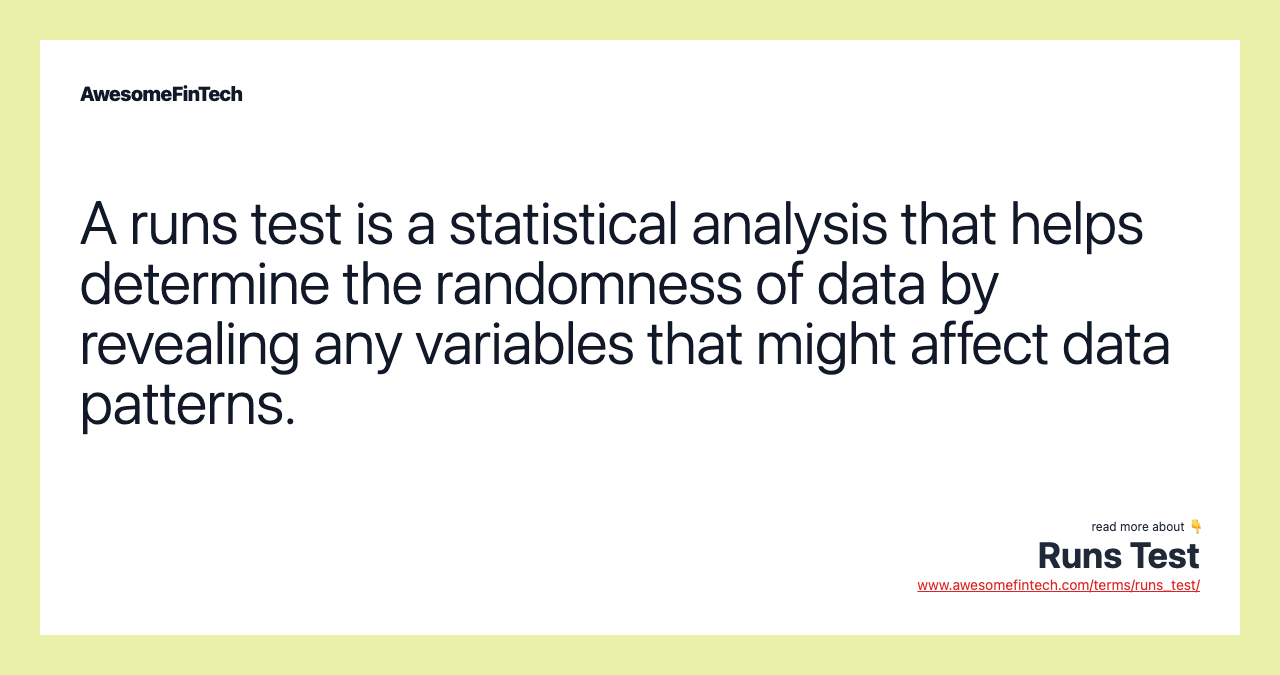Runs Test
A runs test is a statistical procedure that examines whether a string of data is occurring randomly from a specific distribution. Two powerful ways traders can use a runs test include: 1. Testing the randomness of distribution, by taking the data in the given order and marking with a plus (+) the data greater than the median, and with a minus (-) the data less than the median (numbers equalling the median are omitted.) 2. Testing whether a function fits well to a data set, by marking the data exceeding the function value with + and the other data with −. A runs test, also known as the Wald–Wolfowitz runs test, was developed by mathematicians Abraham Wald and Jacob Wolfowitz. The runs test is a shortened version of the full name: the Wald–Wolfowitz runs test, so named after mathematicians Abraham Wald and Jacob Wolfowitz. Some statisticians believe another type of runs test — the Kolmogorov–Smirnov test — is a better tool than the Wald-Wolfowitz test for detecting differences between distributions.

What Is a Runs Test?
A runs test is a statistical procedure that examines whether a string of data is occurring randomly from a specific distribution. The runs test analyzes the occurrence of similar events that are separated by events that are different.
In investing, a runs test can be important for investors to determine if the data set they are using is randomly generated or if it is impacted by an underlying variable. Traders who focus on technical analysis can use a runs test to help analyze the price action of a security.




Understanding a Runs Test
A run is a series of increasing or decreasing values, often represented on a chart by plus (+) or minus (-) symbols. In statistics, a runs test helps determine the randomness of data by uncovering any variables that might impact data patterns.
For example, a list of truly random single-digit numbers should only have a few instances where a sequence of numbers is ascending numerically. However, in many cases, it is difficult to assert the randomness of data in which there are thousands of sequences in a string of data. Thus, the runs test was created as an objective method of determining randomness.
Types of Runs Tests
The runs test is a shortened version of the full name: the Wald–Wolfowitz runs test, so named after mathematicians Abraham Wald and Jacob Wolfowitz. The Wald-Wolfowitz test is a nonparametric statistical test, which means the data being analyzed does not have to meet certain assumptions or parameters. The Wald-Wolfowitz test can be used to examine the hypothesis that the variables in the data string are mutually independent.
Some statisticians believe another type of runs test — the Kolmogorov–Smirnov test — is a better tool than the Wald-Wolfowitz test for detecting differences between distributions. The Kolmogorov–Smirnov test is a type of goodness-of-fit test that demonstrates if the sample data being tested represents normal distribution patterns or if the data is somehow skewed. The test establishes the discrepancy between the values in the sample data and the normal distribution model.
Benefits of a Runs Test
The runs test model is important in determining whether an outcome of a trial is truly random, especially in cases where random versus sequential data has implications for subsequent theories and analysis. A runs test can be a valuable tool for investors who employ technical analysis to make their trading decisions. These traders analyze statistical trends, such as price movement and volume, to spot potentially profitable trading opportunities. It's important for these traders to understand the underlying variables that could be impacting price movement and a runs test can help with this.
Two powerful ways traders can use a runs test include:
- Testing the randomness of distribution, by taking the data in the given order and marking with a plus (+) the data greater than the median, and with a minus (-) the data less than the median (numbers equalling the median are omitted.)
- Testing whether a function fits well to a data set, by marking the data exceeding the function value with + and the other data with −. For this use, the runs test, which takes into account the signs but not the distances, is complementary to the chi-square test, which takes into account the distances but not the signs.
Related terms:
Central Limit Theorem (CLT)
The central limit theorem states that the distribution of sample means approximates a normal distribution as the sample size gets larger. read more
Chi-Square (χ2) Statistic
A chi-square (χ2) statistic is a test that measures how expectations compare to actual observed data (or model results). read more
Data Analytics
Data analytics is the science of analyzing raw data in order to make conclusions about that information. read more
Goodness-of-Fit
A goodness-of-fit test helps you see if your sample data is accurate or somehow skewed. Discover how the popular chi-square goodness-of-fit test works. read more
Hypothesis Testing
Hypothesis testing is the process that an analyst uses to test a statistical hypothesis. The methodology employed by the analyst depends on the nature of the data used and the reason for the analysis. read more
Median
The median is the middle number in a sorted, ascending or descending, list of numbers and can be more descriptive of that data set than the average. read more
Nonparametric Method
Nonparametric method refers to a type of statistic that does not require that the data being analyzed meet certain assumptions or parameters. read more
Nonparametric Statistics: Overview
Nonparametric statistics refer to a statistical method in which the data is not required to fit a normal distribution. Rankings should not change. read more
Normal Distribution
Normal distribution is a continuous probability distribution wherein values lie in a symmetrical fashion mostly situated around the mean. read more
Objective Probability
Objective probability is the probability that an event will occur based on an analysis in which each measurement is based on a recorded observation. read more